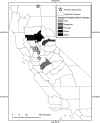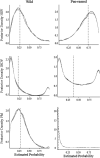Health surveillance of a potential bridge host: Pathogen exposure risks posed to avian populations augmented with captive-bred pheasants
- PMID: 33711203
- PMCID: PMC9290078
- DOI: 10.1111/tbed.14068
Health surveillance of a potential bridge host: Pathogen exposure risks posed to avian populations augmented with captive-bred pheasants
Abstract
Augmentation of wild populations with captive-bred individuals presents an inherent risk of co-introducing novel pathogens to naïve species, but it can be an important tool for supplementing small or declining populations. Game species used for human enterprise and recreation such as the ring-necked pheasant (Phasianus colchicus) are commonly raised in captivity and released onto public and private wildlands as a method of augmenting naturalized pheasant populations. This study presents findings on pathogen exposure from three sources of serological data collected in California during 2014-2017 including (a) 71 pen-reared pheasants sampled across seven game bird breeding farms, (b) six previously released pen-reared pheasants captured at two study sites where wild pheasants occurred and (c) 79 wild pheasants captured across six study sites. In both pen-reared and wild pheasants, antibodies were detected against haemorrhagic enteritis virus (HEV), infectious laryngotracheitis (ILT), infectious bursal disease virus (IBDV), paramyxovirus type 1 (PMV-1) and Pasteurella multocida (PM). Previously released pen-reared pheasants were seropositive for HEV, ILT, and PM. Generalized linear mixed models accounting for intraclass correlation within groups indicated that pen-reared pheasants were more than twice as likely to test positive for HEV antibodies. Necropsy and ancillary diagnostics were performed in addition to serological testing on 40 pen-reared pheasants sampled from five of the seven farms. Pheasants from three of these farms tested positive by PCR for Siadenovirus, the causative agent of both haemorrhagic enteritis in turkeys and marble spleen disease of pheasants, which are serologically indistinguishable. Following necropsy, owners from the five farms were surveyed regarding husbandry and biosecurity practices. Farms ranged in size from 10,000 to more than 100,000 birds, two farms raised other game bird species on premises, and two farms used some form of vaccination. Biosecurity practices varied by farm, but the largest farm implemented the strictest practices.
Keywords: California; game birds; pen-reared; poultry diseases; ring-necked pheasant; surveillance.
© 2021 The Authors. Transboundary and Emerging Diseases published by Wiley-VCH GmbH. This article has been contributed to by US Government employees and their work is in the public domain in the USA.
Conflict of interest statement
The authors declare no potential conflicts of interest with respect to the research, authorship, or publication of this article.
Figures


References
-
- Bevins, S. N. , Dusek, R. J. , White, C. L. , Gidlewski, T. , Bodenstein, B. , Mansfield, K. G. , & Deliberto, T. J. (2016). Widespread detection of highly pathogenic H5 influenza viruses in wild birds from the Pacific Flyway of the United States. Scientific Reports, 6, 28980. 10.1038/srep28980 - DOI - PMC - PubMed
-
- California Department of Fish & Wildlife (CDFW) . (2017). 2017 Game Breeder Public Permit List. Sacramento Retrieved from https://www.wildlife.ca.gov/Licensing/Game‐Breeder
-
- California Department of Food and Agriculture (CDFA) . (2019). Virulent Newcastle disease alert. Retrieved from https://www.cdfa.ca.gov/ahfss/Animal_Health/Newcastle_Disease_Info.html
MeSH terms
Grants and funding
LinkOut - more resources
Full Text Sources
Other Literature Sources

